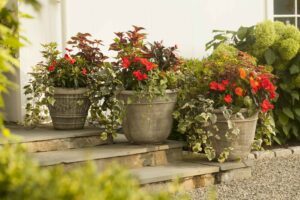Five Steps to Creating a Thriving Ecosystem in Your Backyard
Explore the plants that attract and aid butterflies and birds.
There has been a growing trend in recent years for creating more natural backyard ecosystems and, in turn, making them more bird and butterfly friendly. After all, these are the creatures we rely upon to pollinate our plants and sustain our food and natural resources. Luckily, creating a beautiful home landscape while also preserving biodiversity has never been easier. Here are five ways to make your own backyard into a wildlife-supporting habitat.
1. Manage Invasives

Most of the non-native or exotic plants you’ll find on properties in our area (ie. azaleas, boxwood, roses) are harmless to our eco-systems. However, there are some that have gotten out of control, choking out and displacing native species that are crucial to our local wildlife. Identifying and removing invasives is an important first step in creating a backyard eco-system. Our property care teams have years of experience managing these unwanted plants.
2. Plant Native Species
It’s possible, of course, to create a beautiful home landscape using native plants only—but even just adding a few varying species goes a long way. Did you know, for instance, that a native oak tree can support the caterpillars of around 500 species of butterflies and moths? Their larvae are a major source of food for our local songbirds. Native herbaceous perennials such as monarda and lobelia will attract hummingbirds to your property, as they feed on these flowers’ nectar. Want to see a steady stream of monarch butterflies coming through? Plant some goldenrod, asters, or coneflowers. And consider a patch of milkweed; it’s the only plant monarch caterpillars will eat. Let us help you select native plants (that have evolved to support our local food webs), and create balance between the needs of wildlife and our desire to be surrounded by beauty.
3. Provide Cover for Birds and Bugs

Shrubs offer smaller birds a place of protection from predators and bad weather, as well as cover for nesting and foraging for food. Trees (like the oak mentioned above), act as perches for larger birds. And leaving some leaves in undisturbed areas on your property during fall clean-up is beneficial to the caterpillars that over-winter in leaf piles.
4. Add Water

Bathing in water is an important facet of birds’ feather maintenance. And a birdbath can be an entertaining focal point in a smaller garden. Have more space? We have designed and installed small ponds on many properties. Not only will the birds benefit, but you’ll attract other wildlife—such frogs and bats that which will feed on unwanted insects like mosquitos.
5. Go Organic
Many homeowners choose to limit synthetic chemical use out of concern for the safety of their pets and families. This is also one of the easiest ways to enhance the presence of wildlife in our home landscapes. When it comes to use of herbicides for weeds, Glengate takes care not to over-treat affected problem areas with heavy-handed chemical applications. But we do also have a comprehensive organic program that includes OMRI- and NOFA-approved products. Just one more way we can help you create your own thriving backyard eco-system.


